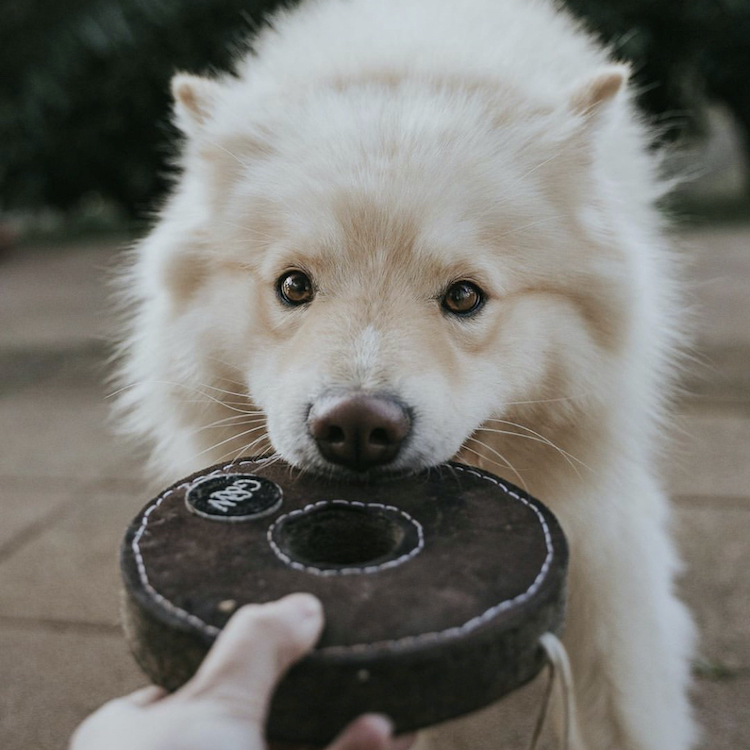
Being a dog owner and being environmentally conscious can be quite tricky at times. The world of dog products is flooded with consumables, plastic packaging on treats, poor quality toys and with almost 10 million dog owners in the UK (PDSA Animal wellbeing report 2019), this creates a huge amount of waste. Not to mention the organic dog waste too!
But it’s not all doom and gloom as there are things that can be easily achieved to reduce both yours and your dog’s environmental footprint. Sustainability is a complex area and requires a holistic approach, making sure that you are conscious of all aspects of the environment. While recycling and reducing your plastic consumption is a great place to start, you can go even further by following the below “Four R’s” motto.
Refuse, Reduce, Reuse, Recycle
By eliminating excess in the first instance, (product or packaging) and being conscious of other environmental impacts such as energy or water used during production, you can rest assured that when you finally decide on products to use, you have already made a conscious choice that benefits the environment.
However, as dog owners, it is inevitable that we will need to purchase products for our dogs, including consumables such as food, treats, toys, beds and the ultimate environmental nightmare, the poop bag.
It’s estimated that in 2020, the pet food industry will reach spending of £2.9 billion, and will continue to grow year on year (Mintel report, pet food industry) With that volume of food and treats comes a huge amount of packaging.
Simple changes that you can make are to buy your food in bigger bags, which reduces packaging, and less frequently to reduce the number of deliveries you receive helping to reduce your carbon footprint.
If you want to go one step further, try and switch to brands that offer home compostable, or reusable packaging. There are now options on the market for dry, wet and raw products that offer this type of packaging, and some even provide incentives for returning the packaging.
Sadly, there is no easy clear-cut choice when it comes to the best type of packaging for pet products as there are pros and cons to all materials (Better Meets Environment).
Aluminium requires both mining and a huge amount of energy to initially produce but only 5% of that energy to recycle and can be recycled infinitely, while PET plastic requires less energy to produce initially, but requires crude oil extraction and can currently only be recycled a number of times before it is no longer usable.
Whichever you choose, double-check with your local authorities to check which types of products they can recycle. You can also lookup Terracycle, a private recycling firm that offers recycling schemes specifically for not only pet food trays and pouches, but other items too which may not otherwise be able to be recycled.
“One of the easiest switches you can make is to change from plastic bags, which will not degrade in landfill, to a compostable option.”
The next area in which you can make a huge difference to your environmental footprint is poo bags. It is estimated that in the UK, dogs create over 1,000 tons of dog poo a day! And if each one of those is picked up, and put into an individual bag – that is a lot of poo bags.
One of the easiest switches you can make is to change from plastic bags, which will not degrade in a landfill, to a compostable option. When ordering bags be careful to check the labels there is a big difference between biodegradable, compostable and home compostable bags.
Biodegradable bags are generally made of plastic with a degradable additive that is added to the material. These bags still take a very long time to break down (as referenced in this study, in some cases it can take years) and the pieces that remain can still be harmful to the environment, especially if they end up in the sea as the much heard about microplastics.
Compostable bags however are not made from plastic at all. Most are made from plant-based compounds (namely Cornstarch) which means that when they compost, they break down into harmless, organic matter. There are two types of compostable bags – those that are suitable for industrial composting, and those suitable for composting at home. The difference is that industrial composters can reach higher temperatures which some materials need to break down.

Home composting is an environmentally friendly way to dispose of organic home waste, providing you with a great soil enricher at the end.

If you fancy going one step further, one of the things you can consider is composting your dog poo at home. Dog poo compost (when processed properly) reaches a high enough temperature to kill all of the harmful pathogens that are present. A study completed by the United States Department of Agriculture (colloquially known as the Alaska report as it was conducted on a husky mushing team!) helpfully outlines the necessary requirements to ensure the compost is safe.
There are different types of composters available to buy (or if you are feeling creative, build!) including those where the compost goes back into the ground or those like wormeries, where you can use the finished result. Stick to using this on non-edible plants though – just in case.
Another really important area of your dog’s life that can also be filled with eco-friendly options is, play! When looking for environmentally friendly dog toys, there are plenty of options to please your pooch.
Using the four R motto, you can find lots of ways to reuse existing products around the house which make great dog toys. Upcycling old or odd socks into pass the parcel type toys, with treats hidden between each of the layers, or use old packaging with paper shred to create snuffle boxes with hidden treats or toys inside – the options are endless!
If you prefer to buy toys, wooden toys offer a great option for those dogs that like to chew. Make sure you pick a size appropriate toy made from non-splintering wood like olive or coffee wood to make it last longer and reduce the risk of it being broken into smaller pieces. As with all chews, please do not leave your dog unattended, and make sure to compost it once the pieces are too small for your dog to chew safely.
Another option is toys made from natural fibres. Hemp or Jute rope is made from natural fibres, and much easier to break down than traditional cotton rope toys should your dog manage to free some of the fibres. Both hemp and jute are amazing fabrics; they take much less water to grow than cotton as they rely on natural rainfall rather than irrigation, don’t require as many pesticides or fertilizers and can be composted after use.
These two fabrics can also be used in bedding or stuffing for toys. If you have a shredded rope toy, you can also pop it in a laundry bag, give it a wash and then use it to stuff and reuse a plush toy that has received the inevitable de-stuffing!
Top Tips to Take Away
- Try as much as you can to reduce your consumption of any product. Bulk buy food, purchase longer lasting toys, and if you fancy it – compost your poop instead of using bags!
- Reuse where you can – donate unwanted beds to animal rescue charities, upcycle your own old clothes into beds and toys, and use unwanted paper or cardboard packaging and turn it into fun engagement toys.
- When you have a product that has reached the end of its life, recycle it whenever possible. Remember aluminium is closed-loop and fully recyclable, while plastic packaging may not be. Look out for schemes that are specifically designed to recycle pet food packaging.
- Be aware of the difference between biodegradable, compostable and home compostable when selecting products.
Our Expert
This article was written by Joanna Baker, owner of Collar Club, a natural subscription box for dogs and sustainability professional. Each product in a Collar Club box is selected with sustainability in mind, to ensure that your pup is introduced to the best quality products without it costing the earth.
For more information: www.collarclub.co.uk
